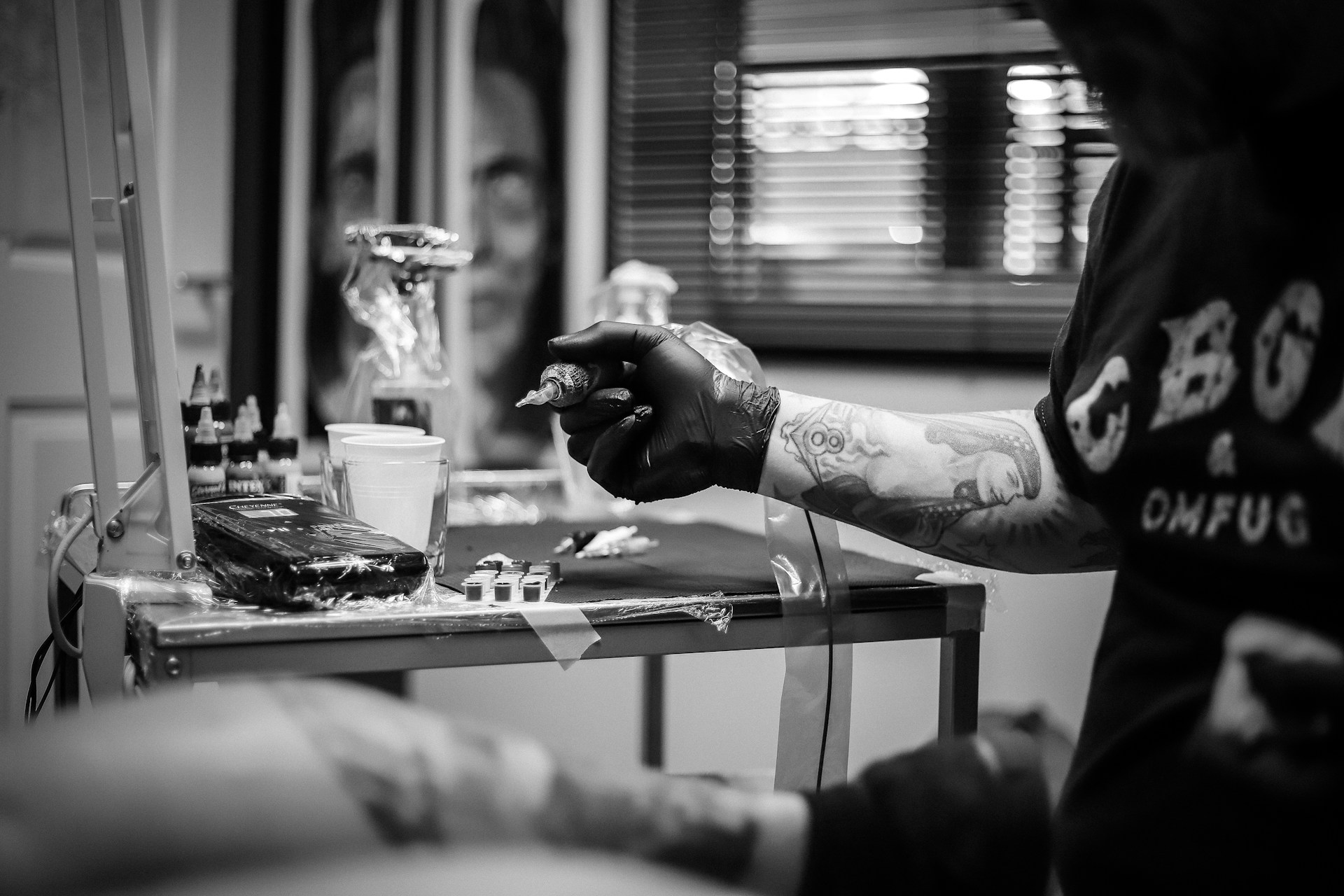Steps to become a tattoo artist
- Learn how to draw a tattoo design
- Get your bloodborne pathogens certification
- Improve fundamental skills and qualifications
- Get licensed in your state
- Market and advertise your services
- Schedule tattoo appointments
- Collect consent forms
- Payment and tips collection
- Continue developing your skills
- Keep current with trends
If you’re artistic, creative, and passionate about tattoo art, then becoming a tattoo artist might be the ideal career path for you.
Tattoo artists use specialized equipment to create permanent art on the skin. Artists not only perform the actual tattooing, but they also consult with clients, develop their ideas into sketches and designs, and stay updated about industry trends and techniques.
A career as a tattoo artist can be very rewarding. You’ll have the chance to develop your own styles and techniques as well as to help your clients express themselves through art every day.
Becoming a tattoo artist takes time, and it’s a multistep process. While this process takes plenty of work, it could ultimately result in a career that you love. Here’s what you need to know about making this dream career into a reality.
Discover how a world-renowned tattoo artist successfully manages her business with Jotform. Learn from the best and streamline your path to success.
1. Learn how to draw a tattoo design
The first step to becoming a tattoo artist is to learn how to draw tattoos. Focus on developing your drawing skills and draw often. Study the work of other tattoo artists, create your own designs, and practice having friends and family describe a design or idea for you to draw.
Since your drawing skills will help differentiate you from other tattoo artists, invest in developing those skills. You might want to take art classes through a local community college or at least enroll in some virtual art training online. Alternatively, some tattoo artists decide to earn a traditional art degree, immersing themselves in different techniques and developing their skills.
2. Get your bloodborne pathogens certification
Since blood can transmit life-threatening diseases, you’ll need to complete bloodborne pathogens (BBP) certification to learn how to protect yourself and your clients. Most states require tattoo artists to have a BBP certification to be licensed.
You can often complete this training online; the National OSHA Foundation and the American Red Cross both offer the training. Your certification is good for one year, so you’ll need to retake the course many times during your career.
3. Improve fundamental skills and qualifications
Before you can become a licensed tattoo artist, it’s important to develop your skills and qualifications so that you’re well prepared for this career.
Consider getting an apprenticeship at a licensed tattoo business. Apprenticeships give you valuable supervised and firsthand experience. Plus, your state might require you to complete a certain number of apprenticeship hours before you can get your license.
4. Get licensed in your state
You need to have a license to be a tattoo artist. License requirements vary depending on your state and your local health department. In most cases, you can expect to pay a licensing fee of about $100.
Additionally, you’ll need to meet your location’s tattoo licensure requirements. These requirements may include
- Filling out a licensure application
- Completing a college-level anatomy or physiology course
- Taking a bloodborne pathogens and disease transmission class
- Completing a basic first aid course
- Completing a basic CPR course
Some states may also require you to complete an apprenticeship with a licensed tattoo establishment. The state or department of health may require a minimum internship of at least two years.
Before you apply for a license, check with your local department of health and verify the licensure requirements that you’ll need to meet. Researching these requirements well ahead of time can help you prepare and ensure that you’ll be able to meet all of them.
5. Market and advertise your services
As a licensed tattoo artist, you can work in a tattoo shop, or you can even start your own tattoo business. No matter which career path you take, it’s important to start building up your client base.
Effective marketing and advertising can help you spread the word about your services, secure your initial clients, and fill your books. As a tattoo artist, you may want to consider a combination of different marketing and advertising strategies.
Maintaining an active social media presence is essential for marketing and advertising your business. Include photos not only of your work but also of your shop to show customers that you run a clean, welcoming business. Be sure to engage with your followers and promptly respond to questions.
You can also use your social media to run ads and sponsored posts, expanding your audience and connecting with potential clients.
Take the time to build a professional website. The site should include a portfolio of quality photos of your work. Videos can be a great addition to your site too, showcasing your process of sketching and developing a tattoo to build potential clients’ confidence in your services.
Don’t forget the importance of word-of-mouth marketing and referrals. Consider offering your clients a discount on future services for every new client they refer to your business.
6. Schedule tattoo appointments
As you schedule your tattoo appointments, it’s important that you’re organized. Staying on top of the administrative side of your business will help you treat your clients with professionalism, and it will ensure that you’ve reserved enough time for each appointment to give every client the attention they deserve.
When you use Jotform, you can build your own forms and then easily share them on your website, through email or text, and even on social media. With Jotform’s appointment form templates, your clients can complete the forms to schedule an appointment, making for a streamlined scheduling process.
You can choose from several tattoo-specific forms:
- Tattoo appointment form: This registration form helps you manage appointments and collect client information.
- Tattoo booking form: Use the tattoo booking form to gather information about your clients and their tattoo interests. This form can help you better organize and manage your schedule.
You can even use the Jotform tattoo booking app to make it easier to gather client information. Clients can use the app to fill out their contact information and medical details as well as sign a terms and conditions waiver. The app also includes a pre-procedure questionnaire to help you collect essential information.
In addition, Jotform offers an appointment scheduling feature to schedule appointments, receive meeting requests, and more. Since Jotform integrates with Google Calendar, whenever a client books an appointment, it’s automatically added to your calendar, saving you time and keeping your schedule up to date.
To complete the scheduling process, you can set up autoresponders with Jotform. The autoresponders can include information about appointments, providing clients with all the necessary details.
7. Collect consent forms
It’s critical to collect consent forms before tattooing a client. Jotform’s tattoo artist forms include templates for everything from tattoo requests to consent forms.
Consent forms ensure that all parties understand the risks and responsibilities involved in tattooing, and Jotform’s tattoo consent form is a great place to get started. Plus, clients can complete the form before the appointment so you can dedicate the full appointment time to working with them instead of doing paperwork.
8. Payment and tips collection
Jotform makes it easy to collect payments and tips. Since Jotform integrates with numerous payment processors, such as PayPal, Stripe, Square, and 2CheckOut, you can offer the payment methods that are most convenient for your clients.
Jotform’s tattoo gift certificate template simplifies the process of selling gift certificates, an ideal way to boost sales and attract new customers.
9. Continue developing your skills
One of the fantastic benefits of being a tattoo artist is that this career gives you endless growth opportunities. As you develop your skills, you can explore new techniques, work with new styles, expand your portfolio, and grow as an artist. As you become more skilled and develop a defining style, you’ll be able to charge more for your work too.
No matter where you are in your career, continuously focus on developing your skills. You may even need to complete a certain number of continuing education hours each year to keep your license.
Your local community college may offer continuing education courses, or you could take courses online. Enrolling in arts courses, attending industry conferences, and simply studying the work of other artists and honing your artistic skills are all important in furthering your career.
10. Keep current with trends
Finally, be sure to stay current with trends, which evolve rapidly in the tattoo world. You’ll quickly find that clients are looking for artists who can deliver on the styles and techniques that are hot at the moment.
Attending competitions, staying active on social media, and reading industry publications can all help you keep track of the newest and emerging trends so you can stay competitive.
Photo by Pavel Danilyuk



































Send Comment: